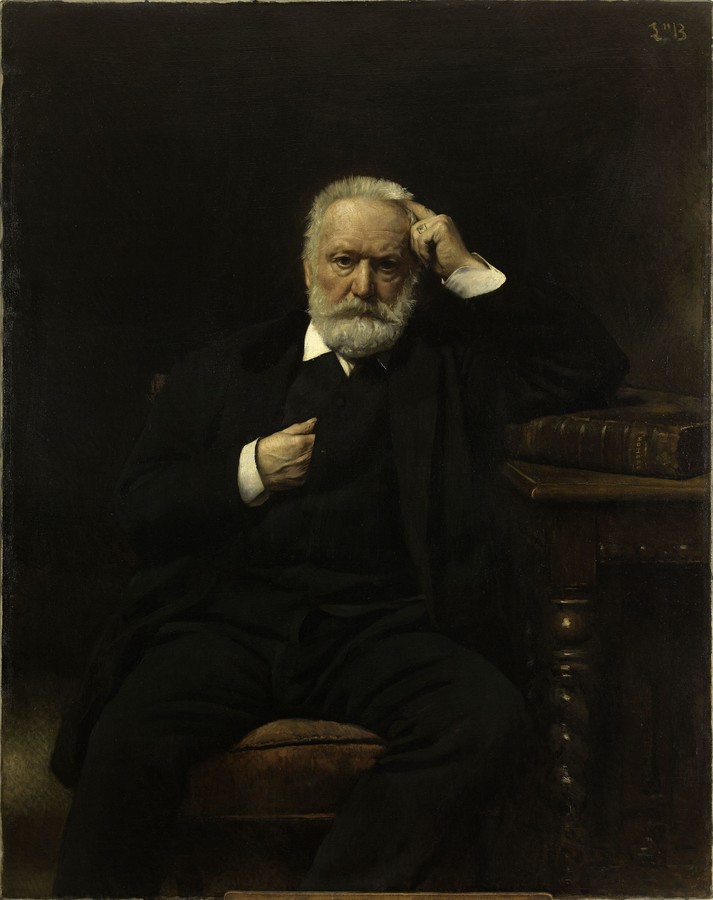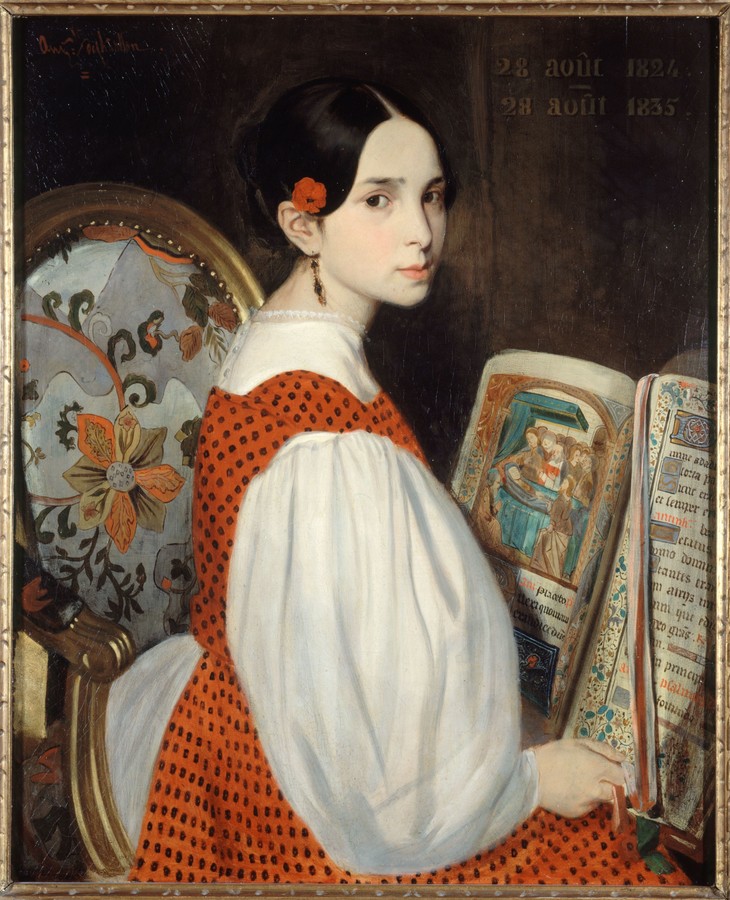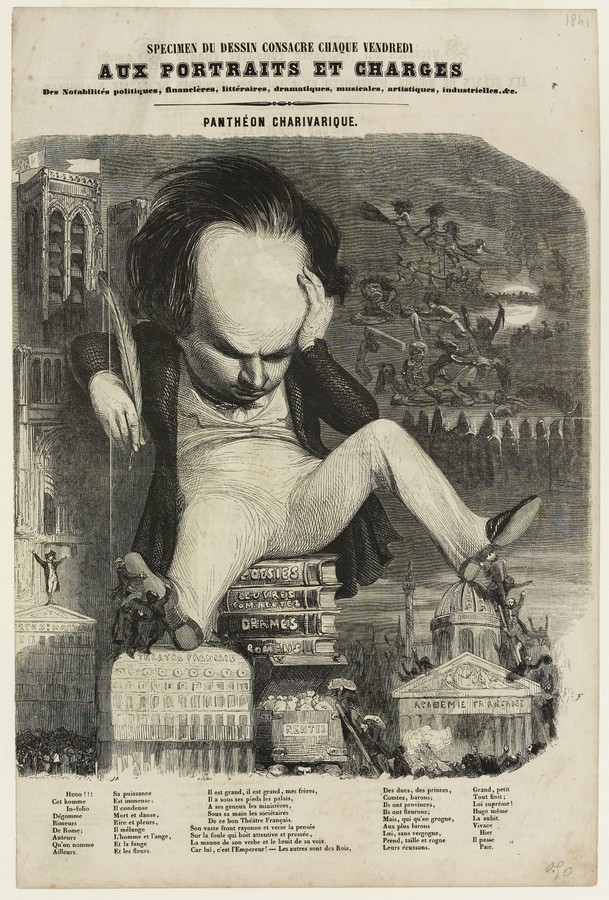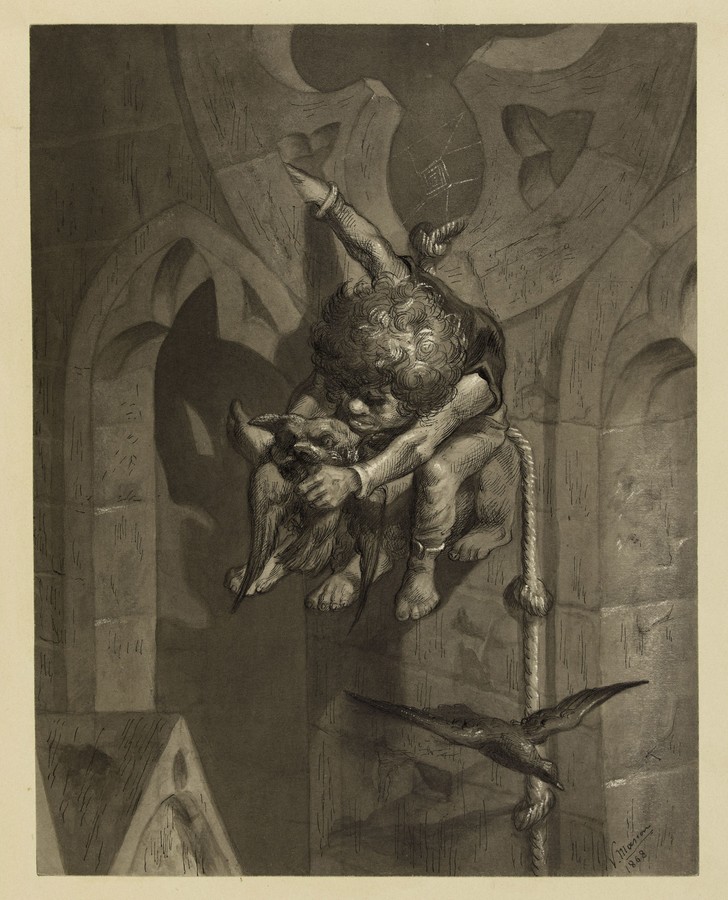
Victor Hugo
VICTOR HUGO: DANS L’INTIMITÉ DU GÉNIE Painting / Huile sur toile 27,1 x 21,7 cmThis painting is a replica of the great portrait of Victor Hugo, displayed by Louis Boulanger, at the 1839 Salon, a great annual painting exhibition at the Louvre and one of the biggest artistic event at the time. The original one is currently stored at Hauteville House, Hugo’s exile mansion in Guernsey. This second version has been made by the painter especially for Juliette Drouet, whom pressed for it as a token of love. The young romantic painter Louis Boulanger was a close friend of Victor Hugo - the poet even called him « my painter ». Boulanger was often inspired by Hugo’s poems, and made portraits of all the Hugo family. Here is represented Victor Hugo with a black sober and simple costume, that enhances the red ruban of his legion of honour, awarded by the king Charles X. Even though his long swept back hair recalls the poet that he was ; the seriousness of his outfit recalls that he was also a candidate at the Académie française, where he will be elected in 1841.

Portrait de M. Victor Hugo
VICTOR HUGO: DANS L’INTIMITÉ DU GÉNIE Painting / Huile sur toile 137 x 109.1 cmThe sittings had begun on November 1878, when Victor Hugo came back to Guernsey from his last trip. The painting has been displayed in 1879 at the Salon, a great painting exhibition in Paris. Léon Bonnat was a great painter from the Third Republic but also one of the most renowned portraitist. This portrait of Hugo became one of the most famous representation of the writer. The composition is close to one of Nadar’s photographs, with Hugo leaning on a table, his head on his hand. This is the meditating poet, the experienced old man who seems to sift through all of this fights, and look at the future. With this almost formal aspect, this portrait is one of the universal poet but also one of the major figures of the Republic. This image is engraved in collective memory and became the main representation of Victor Hugo. After Victor Hugo’s death, Bonnat’s painting became the property of his grant daughter Jeanne. For the opening of the museum of Maison de Victor Hugo in 1903, Paul Meurice - a close friend of Hugo - asked for a reproduction, made by Daniel Saubes, a student of Bonnat.

Léopoldine au Livre d'Heures
VICTOR HUGO: DANS L’INTIMITÉ DU GÉNIE Painting / Huile sur toile 73 x 60 cmTwo romantic painters made portraits of Victor Hugo and of his family : Louis Boulanger and Auguste de Châtillon. Louis Boulanger had made a portrait of Léopoldine, the elder daughter of Hugo, when she was 4 years old. Auguste de Châtillon made her portrait when she was an adolescent at the age of 11. She is represented sitting on a flower embroidered chair, reading a manuscript from the Middle-Age with a representation of the Virgin Mary - a reference to her communion, but also to her father who wrote The Hunchback of Notre-Dame. After Léopoldine’s death in 1843, this portrait became a cult object for Victor Hugo, that will forever be affected by this incident. The gown she is wearing on this portrait had also been stored by Mrs Hugo, like an artefact that Hugo mentions in one of the poems of Les Contemplations : « Oh la belle petite robe / Qu’elle avait, vous rappelez-vous ? ».

« Victor Hugo, Panthéon Charivarique », Le Charivari, n°345
VICTOR HUGO: DANS L’INTIMITÉ DU GÉNIE Print / Imprimé, gravure sur bois 8.6 x 24.4 cmIn the 1830s, caricature became a prominent style with the development of illustrated press. In this one, Benjamin Roubaud depicts the thinker Victor Hugo with a disproportionate forehead, sitting on his works, leaning against Notre-Dame, and with a bucket of gold - showing that his success brings in money. At the bottom left corner, the buildings of la Comédie-Française and of the Théâtre Saint Martin are reminders of Hugo’s plays. The leader of Romanticism - a literature protest movement that was well known - is clearly mocked here, as are depicted the witch’s sabbath at the top (which refers to his poems) and at the bottom the pastiche of one of the most famous poems of Les Orientales : Les Djins.

Esméralda
VICTOR HUGO: DANS L’INTIMITÉ DU GÉNIE Painting / Huile sur panneau 60 x 38.7 cmThroughout the 19th century, The Hunchback of Notre-Dame never ceased to be a source of inspiration for artists. Esmeralda - with her tambourine and the goat Djali - has been one of the most represented characters of the novel. Depending on the artists, her outfits are changing. In the novel, Esmeralda is wearing a short dress, as depicted in Eustache Morin’s engravings. Here, she is wearing a long dress inspired from the 1889 illustration of Luc-Olivier Merson. This inspiration is noticeable in this painting by Lionel Royer, another important artist in the late 19th century French art.

C'était Quasimodo dénichant des corbeaux - livre IV, chap.III
VICTOR HUGO: DANS L’INTIMITÉ DU GÉNIE Painting / Encre sur papier 25,7 x 20,2 cmVictor Masson’s artist career was troubled by the need to take care of his family business. However, he continued to practice his art. As a literature amateur, he drew inspiration from works that he cherishes, such as The Hunchback of Notre-Dame. Thus, in 1868, he made a series of drawings to illustrate the novel. They reflect the lasting fame of the book, well-established in the literature hall of fame. The period of time is also related to a renewed interest for romanticism, and thus a huge inspiration for a generation of artists. In his drawings, Victor Masson shows a subtle range of lights and chiaroscuro, underlying the dramatic aspect of this scene. Instead of showing Quasimodo astride a bell, Masson gives another image of the character, performing stunts in the air, chasing some crows. The encounter of the monstrous figure of the character and the sublime of the cathedral is a key element of Hugo’s romanticism.

Idole chinoise devant un temple à pavillons bulbeux
VICTOR HUGO: DANS L’INTIMITÉ DU GÉNIE Painting / Encre sur velin 17 x 11,4 cmVictor Hugo started drawing around 1834 during his summer trips with his mistress Juliette Drouet. While he mainly drew caricatures to entertain his relatives and travel drawings in order to keep a memory of the places he visited ; he started in 1837 to draw a series of imaginary places : dreamy deserted landscapes, with strange oriental architectures sometimes adorned with some Chinese characters. In this particular drawing, Victor Hugo highlights the dream-like atmosphere with disproportionate buildings next to a Chinese little statue - probably a little porcelaine trinket as Juliette likes them - that here has a humongous size.

"St-Sampson" (ou Femme de pêcheur regardant la tempête)
VICTOR HUGO: DANS L’INTIMITÉ DU GÉNIE Painting / Encre sur velin 8,9 x 14,3 cmHugo’s drawings became more and more complex over time. While he always used ink as his main material, he developed a sophisticated technique, playing with lines and the wash. He would capture a real story, filled with dreamy emotion and drama. His drawings are seldom related with his written works, and never really look to illustrate them. The only exception may be the series he did in parallel of writing the novel Toilers of the Sea which takes place in Guernsey. This drawing here recalls the novel by the name of the place, Saint Sampson, where the main character lives. Victor Hugo highlights the pathetic aspect of the scene with tenebrism, chiaroscuro that describe the sky, the sea and the fragile silhouette of the woman, powerless in front of the elements.

Ville en plaine
VICTOR HUGO: DANS L’INTIMITÉ DU GÉNIE Painting / Encre, aquarelle, gouache sur papier 11,4 x 18,4 cmEven though during his lifetime, a few of his drawings have been reproduced by engraving, Hugo did not like to show them. His drawings were mainly made for himself or for his kins. Thus, he would often offer some new year cards that he made himself for his friends. These drawings are made in private, and show that Hugo would enjoy to play with his signature, as the big letters of his name would become components of the drawing. The themes of theses cards are often castles or landscapes of a city in a plain. The card here seems to be unfinished as there is no colour and no date (even though it is often the case with Hugo). However, it gives us a glimpse of his drawing style and his inspiration.

Frontispice pour La Légende des Siècles
VICTOR HUGO: DANS L’INTIMITÉ DU GÉNIE Painting / Encre, crayon et gouache sur papier 20 x 14.3 cmThis drawing is dedicated to « Au poète exquis, au coeur grand et charmant, à Paul Meurice ! » - « To the exquisite poet, with a big and charming heart, to Paul Meurice ! ». Paul Meurice used to be one of those young writers in the 1830s, that were fascinated by Victor Hugo. He remained close to him during his whole life, and played an essential role during the exile. As he stayed in Paris, he helped Hugo with several things, the editing and publication of Hugo’s work among other services. Victor Hugo, in order to show his gratitude and friendship, often offered him drawings that Meurice liked to bind to the books, as a frontispiece, like the one displayed here. This drawing was destined to be bind to La Légende des siècles that had recently come out in 1859, but it was at the same time a new year card, like the ones that Hugo was used to sent to his friends. These new year gifts were often more colourful than Victor Hugo’s usual drawings, like this one, that shows a blue sky and a red title. In order to preserve this drawing, it had to be removed from the book several years ago. Paul Meurice is the founder of Maisons de Victor Hugo, museums that aim at preserving the memory of Hugo’s work and also illustrate every aspects of his life.

Projet de frontispice pour "Le Rhin"
VICTOR HUGO: DANS L’INTIMITÉ DU GÉNIE Painting / Encre, fusain et gouache sur papier 21.3 x 11.8 cmThis drawing was made during exile. Le Rhin - the story of the voyages made by Victor Hugo in 1839 and 1840 - had already been published a long time ago. However, it is not impossible that this drawing was intended to adorn a copy of the book as is the case for the Frontispice de la Légende des siècle. Its format is indeed very close to that of the original edition. But for unknown reasons, it remained on a free sheet and we do not know if it was for Paul Meurice and sent to him. Victor Hugo’s travels along the Rhine river have played an essential role in his imagination and the development of his graphic works. The « burgs » - a german name for Middle Age castles - have become one of his favoured subjects. Victor Hugo is certainly aware of this here, where he composes an image in two parts separated by his name in red letters and a branch of leaves, with on top, one of these castle and below, three others in a drawn frame, like a mise en abyme of his own works.

Victor Hugo sur le rocher des proscrits à Jersey
VICTOR HUGO: DANS L’INTIMITÉ DU GÉNIE Photography / Tirage sur papier salé 9,7 x 7,1 cmInvented in 1839, photography is still a new kind of art in the first years of Victor Hugo’s exile. Between 1852 and 1854, in Jersey, Victor Hugo’s sons and Auguste Vacquerie (a friend of the family) shaped the project of an illustrated book about Anglo-Norman islands. Even though the technical means of publishing will be not enable to achieve this project, many photographs will serve to keep the memory of the exile and of many other outcasts on the island. It is also a way for Victor Hugo to spread his image, a symbol of resistance against the Napoleonic Empire. At the time, this political use of photography is quite modern. This image is probably one of the most emblematic of Victor Hugo, as he is standing on the « rock of the outlawed » - named like this as it was possible to see the coasts of France from this standpoint. Victor Hugo is depicted as a lonesome and isolated poet, with a feeling of nostalgia and love for his country, but also firm in his beliefs.

Victor Hugo assis de trois quarts, à Guernesey
VICTOR HUGO: DANS L’INTIMITÉ DU GÉNIE Photography / Tirage sur papier albuminé 25,4 x 19 cmIn Jersey, Hugo meets with Edmond Bacot, a photographer with strong republican beliefs. In 1862, Hugo will invite Bacot to Guernsey for him to take pictures of Hauteville House, that had been fully decorated by Hugo. On this occasion, Bacot took portraits of the writer. This portrait made between June 28 and July 7 of 1862 is one of the first photographs to show Victor Hugo with a beard, that he had grown following his doctor’s advice. The public will discover this new face during the publication of Les Misérables.

Gavroche ramassant des balles pour la barricade
VICTOR HUGO: DANS L’INTIMITÉ DU GÉNIE Painting / Huile sur toile 124,2 x 64,8 cmWilllette was a famous caricaturist and artist at the end of the 19th century. He depicts here a well-known episode of Les Misérables, where Gavroche leaves the barricade to get back his ammunitions before being killed. This is when he sings his renowned song « I am a fallen man/ It's Voltaire's fault / My nose is in the drain / It's Rousseau's fault ». These lyrics are often misinterpreted: people understood it as Gavroche died fighting for Voltaire and Rousseau’s ideas. Actually, it is the opposite: Gavroche is killed by the ones who defend these ideas: the owners and craftsmen, enrolled in the national garde and defending the achievements of 1789 they benefited. Gavroche is defending the 1793’s ideals, more in favor of the poor. The episode is the symbol of a division within the Republican side, that broke out during the 1848 revolution.

L'alouette
VICTOR HUGO: DANS L’INTIMITÉ DU GÉNIE Photography / Tirage sur papier albuminé 24,2 x 15,8 cmHugo wanted the first edition of his works to not be illustrated. Thus, artists had to wait for mass-market editions to come out in order to illustrate them. In 1862, after the immediate success of Les Misérables, the painter Gustave Brion had the idea to do an independent illustration. Between April and July, he made 25 drawings, that he reproduced in photographs, a cheaper and faster mean than engraving. Sold by the piece or in photobooks, these pictures were printed in 3 different formats, with two of them matching the French and Belgian editions. Therefore, readers could bind the photos and the book. Hugo welcomed the quality and accuracy of Brion’s drawings. They truly created the visual identity of the characters, and have often been replicated later.

Affiche publicitaire pour le film Les Misérables de Capellani
VICTOR HUGO: DANS L’INTIMITÉ DU GÉNIE Print / Impression sur papier 88,7 x 103,2 cmThe success of Les Misérables has not faded after its publication. The novel has generated several adaptations, to both theatre and film. Albert Capellani (1874-1931) has been one of the pioneers of cinema and gave the first cinematic adaptations of literature masterpieces such as The Hunchback of Notre-Dame (1911), Les Misérables (1912), Zola’s Germinal (1913) and Ninety-Three by Hugo in 1914. Here is the famous character of Jean Valjean, played by Henri Krauss that has been chosen for the film poster.

Miroir aux oiseaux
VICTOR HUGO: DANS L’INTIMITÉ DU GÉNIE Handcrafts / Bois peint, verre 70 x 65 cmThis mirror is the last decorative work Hugo made during his exile, a few months before his return to France. It gathers all the main aspects of Hugo’s personality. On the frame, the handwritten poem dedicated to his grandson Georges recalls the poet. The outcasted republican is embodied in the mention of his trial in Paris at the bottom of the frame « Drawn in May 1870, while I am still tried in Paris ». The artist is referred by the splendid painting of flowers and birds on the frame. He offered this mirror to Juliette Drouet for her feast. As often happens in Hugo’s work, this is based on a paradox : the dim political context and the exile are contrasting with the joyfulness of the painting and the poem.

Portrait de Juliette Drouet
VICTOR HUGO: DANS L’INTIMITÉ DU GÉNIE Painting / Huile sur toile 36 x 31 cmHugo met with Juliette Drouet in 1833, as she was playing a small role for the play Lucrèce Borgia. Their love story, often turbulent, lasted 50 years. Juliette spent her life in the shadow, as Hugo wanted to keep up appearances and preserve his family life. Juliette would write everyday one or two letters to her lover : more than 10 000 letters have been gathered and they represent a rich source of informations about Victor Hugo’s life. It’s only at the end of her life, in 1872, that they lived under the same roof for the first time. This portrait has been made moments before her death in 1883. She appears undermined by her cancer, but she still seems to hide her pain under a veil of resignation and dignity towards death. Jules Bastien-Lepage, a master of naturalism captures with great accuracy this state of mind, making it the most powerful portrait of Juliette.

Victor Hugo avec Georges et Jeanne
VICTOR HUGO: DANS L’INTIMITÉ DU GÉNIE Photography / Tirage sur papier albuminé 13,8 x 10,2cmAfter the deaths of his sons (Charles in 1871 and François-Victor in 1873), Victor Hugo transferred his love on Georges and Jeanne, Charles’ children. He became responsible of their education and shared every moment of his life with them : drawing, story-telling and diners. He celebrated his love for his grandchildren in a collection of poems called The Art of Being a Grandfather (1877). This photograph showing the poet holding Georges and Jeanne in his arms became the emblem of the ideal grandfather that Victor Hugo was in people’s mind.

L'Éclipse, n° 337
VICTOR HUGO: DANS L’INTIMITÉ DU GÉNIE Print / Imprimé d'après lithographie 34,2 x 27,8 cmThe cartoonist and painter André Gill was a great admirer of Victor Hugo. Gill would thus give glowing portraits of the writer, even though he would still use a caricatural and grotesque style. For the publication of Ninety-Three, in 1874, Gill drew Victor Hugo as a sculptor, carving the faces of Danton, Robespierre and Marat. A little girl, presumably Georgette - a character from the novel, is coming out of his pocket, and writes the word « pee-pee » on Marat’s statue.

Victor Hugo, buste héroïque
VICTOR HUGO: DANS L’INTIMITÉ DU GÉNIE Sculpture / Bronze 63 x 56 x 65 cmRodin était très désireux de sculpter le portrait de Victor Hugo, mais ce dernier, âgé et fatigué, ne pouvait accepter les longues séances de pose nécessaire. Il autorisa Rodin à venir parmi les nombreux invités qu’il recevait le soir et à le dessiner. Rodin fit donc de nombreux croquis de Victor Hugo d’après lesquels il réalisa un premier buste en 1883. Rodin recevra en 1889 la commande d’un monument à Victor Hugo, d’abord prévu pour le panthéon, mais que le sculpteur finalisera en 1897, pour le jardin du Luxembourg. Rodin a coutume de reprendre et transformer sans cesse des éléments de ses œuvres. C’est ainsi qu’il isolera de ce monument, ce « buste héroïque » où le poète médite, la tête penchée en avant. C’est sans doute l’image la plus puissante donnée de Victor Hugo, due à la rencontre de l’un des plus grands sculpteurs avec l’un des plus grands écrivains.
